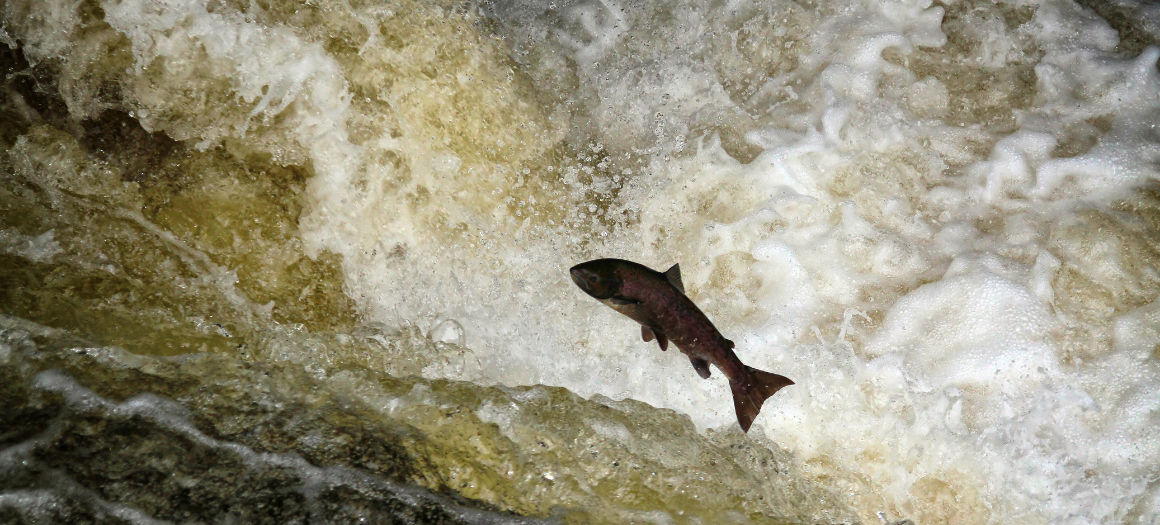WildFish response to Scottish Government’s Wild Salmon Strategy implementation plan

Our director in Scotland, Rachel Mulrenan reviews the Scottish Government’s Wild Salmon Strategy and is largely disappointed. Some positive initiatives are outweighed by the complete failure to address the harm being wrought by salmon farming and an overall lack of urgency in dealing with threats to a population facing extinction.
At the start of February, the Scottish Government published its long-awaited Scottish Wild Salmon Strategy Implementation Plan 2023 – 2028. This implementation plan sets out how the Government aims to achieve its Scottish Wild Salmon Strategy, which was announced in January 2022.
The strategy outlined 12+ pressures impacting on wild salmon stocks, with five concurrent key actions (see notes below). The implementation plan expands on these key actions, with varying levels of detail on delivery deadlines.
The positive
1. Barriers
The pledge to remove or ease 84 active barriers and 94 historic barriers, as well as review a further 66 barriers not covered by an impoundment licence under CAR, may be significant. Removal of these obstacles to spawning habitat has the potential to be an extremely positive step for migrating wild salmon; just how positive will only become clear when a detailed list of obstacles is published.
2. Review of closing times on salmon river seasons
As salmon runs alter (with late autumn runs, in particular, severely diminished), it is questionable whether late closing times, such as the end of November on the Tweed and the Nith, are still justifiable and it makes sense to review them.
3. Restriction/closure of sand eel fisheries
Addressing negative practices that impact on the marine food chain, on which salmon smolts depend, is undoubtedly needed; in addition, Scottish Government action on other environmentally damaging practices, such as scallop dredging, is long overdue.
4. Riparian restoration
The newly developed riparian woodland grant, under the Forestry Grant Scheme, is a step in the right direction, although with reference to ‘improved support for tree planting around rivers and streams’, the implementation plan lacks any concrete objectives for riparian restoration.
The not-so-positive
1. Abstraction abstracted
Despite mention of SEPA’s plans to improve water management, including tackling abstraction, in the Wild Salmon Strategy, the implementation plan makes no reference to this – instead, there is a vague pledge to ‘Develop a strategic approach to water scarcity based on the lessons learnt’, with no specific timeframe given.
2. Reliance on NASCO
The plan makes extensive reference to the North Atlantic Salmon Conservation Organisation (NASCO) as part of its strategy to reverse the decline of wild salmon stocks in Scotland and internationally. However, NASCO itself has no powers; it can only advise. For instance, in relation to sea lice, NASCO adopted the Williamsburg Resolution in 2003, which included this unequivocal goal: ‘there is no increase in sea lice loads or lice-induced mortality of wild salmonids attributable to the farms’. Twenty years on, no tangible, enforceable regulation has been introduced to tackle sea lice levels on Scottish salmon farms.
3. Inaction on sea lice and escapes
In relation to sea lice, the implementation plan refers to the ongoing work by SEPA to develop a ‘risk assessment framework’ for managing the interaction between sea lice from fish farms, and wild salmon and trout. Concerningly there is no deadline stated for this piece of work; which in itself is only initially targeting new farms, not the lice load from existing farms. In relation to escapes, the implementation plan states that it will: “Strengthen controls to reduce farmed fish escapes and explore the introduction of penalties”. Norway, Iceland and Chile already have regulation in place to penalise companies for escaped salmon – on this issue, the Scottish Government, as with sea lice regulation, lags far behind other countries with salmon farming industries.
In summary
As with the strategy itself, the implementation plan displays a severe lack of urgency. Considering that the strategy is based on the “unequivocal evidence that populations of Atlantic salmon are in crisis”, the plan is, for the most part, a disappointing regurgitation of existing legislation and projects, with vague phrasing to ensure inaction in some key areas will continue for at least the next five years.
While there is potential for positive movement to address certain pressures, this overarching lack of urgency, coupled with the failure to adequately address the impacts of salmon farming in particular, means that the plan falls far short of the visionary action needed to save our dwindling wild salmon stocks in Scotland.
Subscribe to latest news and updates
Notes
12+ pressures:
Exploitation, predation, disease and parasites, sea lice, genetic introgression, invasive non-native species, water quality, water quantity, thermal habitat, instream and riparian habitat, obstacles to fish passage, marine development, high seas, other pressures
5 key actions:
- Improving the condition of rivers and giving salmon free access to cold, clean water
- Managing exploitation through effective regulation, deterrents and enforcement
- Understanding and mitigating pressures in the marine and coastal environment
- Making a positive contribution through international collaborations
- Develop and modernised and fit for purpose policy framework




It is of huge concern that the issues over one of Scotland’s most important declining wild animals, the Atlantic Salmon, is not seen as an important situation. The issues are well known to the Scottish Government but ignored. What can we do to apply pressure to the decision makers that ignoring issues is not a method of protecting and growing Scotland’s Economy. The health of Scotland’s river systems and the economy of the Wild Salmon to the country, the smoking industry and the ghillies bailiffs and hospitality industry is big but the Wild Salmon system needs their help not turning a blind eye.